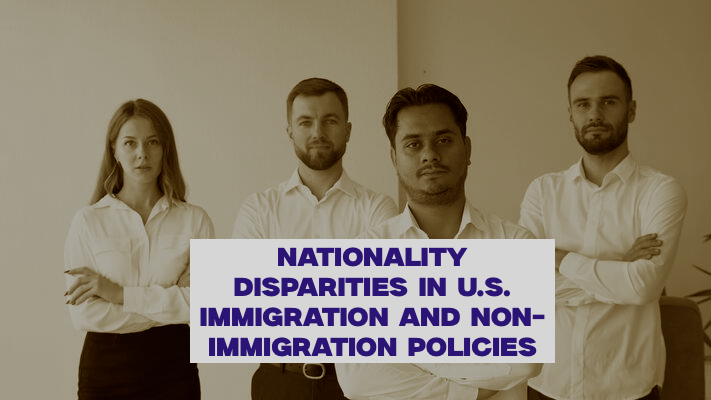
Introduction
The U.S. immigration system is structured around a combination of legal frameworks, international treaties, and historical agreements, which result in disparities among applicants based on their nationality. Certain nationalities face significantly longer wait times, higher rejection rates, and stricter scrutiny compared to others. This is not necessarily due to individual merit or financial capability but is often rooted in geopolitical, economic, and security considerations. A particularly contentious aspect of U.S. immigration policy is how individuals who have acquired new citizenship through naturalization are still subject to restrictions based on their country of birth.
Disparities in Visa Processing: A Case Study on India and the UK
One of the most glaring examples of nationality-based discrimination in the U.S. immigration process is the difference between applicants from India and the United Kingdom. Indian citizens face some of the longest visa processing times, especially for employment-based green cards, due to per-country limits on visa allocations. In contrast, British citizens generally experience much faster processing times and fewer restrictions.
However, even when an Indian-born individual acquires British citizenship, they are often still categorized based on their country of birth when applying for U.S. visas. This means that despite holding a UK passport, they may still face heightened scrutiny and visa delays as if they were still Indian nationals. This is particularly evident in employment-based green card queues, where per-country caps continue to disadvantage applicants born in India, regardless of their current nationality.
Other Examples of Nationality-Based Discrimination
- Chinese-Born Canadian Citizens
- Chinese nationals face significant scrutiny when applying for U.S. visas due to concerns over economic espionage, intellectual property theft, and security risks. Even after acquiring Canadian citizenship, individuals born in China may be subject to extra vetting and delays, particularly in STEM-related visa applications.
- Pakistani-Born British Citizens
- Pakistani nationals experience higher rejection rates for visitor and student visas due to concerns over visa overstays and security issues. Even those who have become British citizens may still face additional background checks and delays compared to ethnically British applicants.
- Iranian-Born European Citizens
- U.S. policies on Iran have led to strict visa restrictions for Iranian nationals. Even if an Iranian-born individual acquires citizenship in France or Germany, they may still face heightened scrutiny due to their country of birth. The Visa Waiver Program also excludes European citizens with Iranian origins from entering the U.S. without a visa.
- Mexican-Born Spanish Citizens
- Mexican citizens face lengthy processing times and stringent requirements for many U.S. visa categories. If a Mexican-born individual acquires Spanish citizenship, they may still be treated as Mexican under certain U.S. immigration protocols.
Why Has the U.S. Implemented These Rules?
The U.S. government justifies these nationality-based policies for several reasons:
- National Security Concerns
- Countries with higher risks of terrorism or espionage (such as Iran, China, and Pakistan) have been historically subject to stricter visa regulations. The U.S. argues that extra vetting for individuals from these countries helps safeguard national security.
- Overstaying and Immigration Fraud Prevention
- Countries with higher visa overstay rates, such as Mexico, India, and Nigeria, often see their citizens subjected to greater scrutiny. The U.S. tracks overstay statistics and adjusts visa approval rates accordingly.
- Reciprocity Agreements and Diplomatic Relations
- The U.S. visa process often reflects how other countries treat U.S. citizens. Some nations, like the UK, have historically strong diplomatic relations with the U.S., leading to smoother visa processes, whereas countries with strained relations, such as Venezuela or North Korea, face greater restrictions.
- Quota Systems and Visa Allocation Limits
- Employment-based and family-based green card categories are subject to per-country limits, which disproportionately affect high-demand countries like India, China, and Mexico. This results in wait times that can exceed decades for applicants from these countries, whereas applicants from low-demand countries (e.g., Norway, New Zealand) obtain green cards much faster.
Criticism of These Policies
While the U.S. government defends these policies on the grounds of security and fairness, critics argue that they:
- Discriminate Based on Birthplace: Treating individuals based on their country of birth rather than their acquired citizenship undermines the principle of equal treatment.
- Harm Skilled Immigration: Highly qualified professionals from countries like India and China face unreasonable wait times for green cards, pushing them to consider other destinations such as Canada and Australia.
- Are Inefficient and Outdated: The per-country quota system fails to account for demographic realities, as large populations like India receive the same number of green card slots as small nations like Iceland.
Potential Reforms
- Eliminating or Raising Per-Country Green Card Caps
- The U.S. could adopt a merit-based system that prioritizes skills and economic contribution rather than birthplace.
- Recognizing Acquired Citizenship Over Birthplace
- The U.S. could revise its policies to treat naturalized citizens based on their current nationality rather than their country of birth.
- Enhancing Visa Processing for High-Skilled Workers
- Expedited green card processing for high-skilled workers from high-demand countries would help prevent brain drain and talent loss to other nations.
Conclusion
U.S. immigration policies, while aimed at protecting national security and economic interests, often result in unequal treatment based on nationality. These disparities disproportionately impact individuals from high-demand and politically sensitive countries, even after they obtain new citizenship elsewhere. As global migration patterns evolve, the U.S. may need to reassess its approach to ensure fairness, efficiency, and competitiveness in attracting global talent.

